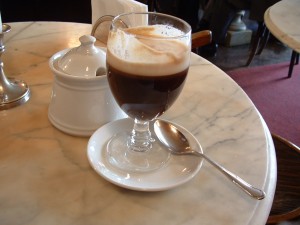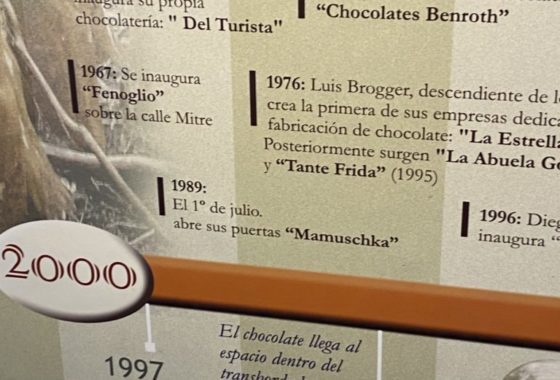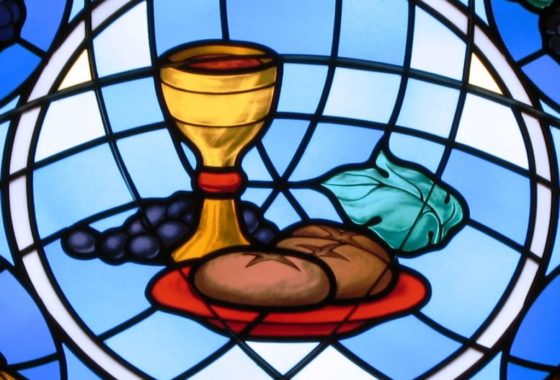Hot Chocolate for Cold Sukkot Nights
 This year make room for chocolate in your Sukkot celebration. Sukkot’s theme of openness symbolized by the leafy ceiling and flimsy walls tempts creative approaches to menus, decorations, and customs. Deuteronomy 16:14’s challenge “v’samachta b’chagecha” (to rejoice in the festival) could easily be fulfilled by layering chocolate onto the holiday’s menus. Sukkot’s custom of welcoming honored guests, known as ushpizin, (traditionally Abraham, Isaac, Jacob, Joseph, Moses, Aaron, David; additionally more recently, Sarah, Rebecca, Rachel, Leah, Miriam, Abigail, Esther) into the Sukkah. What better way to honor a guest than to treat them to tantalizing chocolate concoctions.
This year make room for chocolate in your Sukkot celebration. Sukkot’s theme of openness symbolized by the leafy ceiling and flimsy walls tempts creative approaches to menus, decorations, and customs. Deuteronomy 16:14’s challenge “v’samachta b’chagecha” (to rejoice in the festival) could easily be fulfilled by layering chocolate onto the holiday’s menus. Sukkot’s custom of welcoming honored guests, known as ushpizin, (traditionally Abraham, Isaac, Jacob, Joseph, Moses, Aaron, David; additionally more recently, Sarah, Rebecca, Rachel, Leah, Miriam, Abigail, Esther) into the Sukkah. What better way to honor a guest than to treat them to tantalizing chocolate concoctions.
It could also be fun to recall some of the earlier Jews with significant connections to chocolate by extending a symbolic Sukkah invitation of ushpizin to colonial American traders, retailers and manufacturers such as Aaron Lopez, Rebecca Gomez and Daniel Gomez. From the first of the Jewish chocolate makers ever, in Bayonne, France, include Abraham D’Andrade. Cite Jews who developed the navigational sciences of the 15th-16th centuries which in turn created the opportunity for European first contact with cocoa beans, such as Abraham Ben Samuel Zacuto.
Imagine dried cocoa pods, cocoa beans and other chocolatey decorations hanging from your sukkah or enhancing your festive table. Begin the celebration with a traditional round challah totally doused in chocolate, or a round raisin challah shmeared with chocolate spread, or a round challah encrusted with chocolate chips. On the second night, the salads could be decorated with healthy and crunchy cocoa nibs. For the third night one of the courses could tempt with fresh fruits such as apples, pear and more dipped into chocolate fondue. The fourth night’s main course–chicken, fish or meat–could be smothered in a chocolate mole sauce. Any Sukkot meal could end with a dessert platter of gooey possibilities, perhaps highlighted by delicious truffles and chocolate covered candied apples, their roundness recalling the cycle of the year. Warm up in the cool of the fall evenings with a Mexican style hot chocolate or a rich Italian bicerin lusciously layered with coffee, chocolate and cream. The last night could spotlight chocolate in each course.
Ultimately, whichever recipe, chocolate course, or brand of chocolate you choose to mix in with the first fruits for Sukkot, be sure to blend in the tradition of Sukkot’s themes of appreciation and gratitude by reciting a special shehakol b’racha for the amazing gift of chocolate Enjoy the bounty of the abundant blessings, including chocolate, and a Chag Sameach!
Recipe for Bicerin — Ingredients:
3⁄4 cup whole milk or cream
3 ounces dark chocolate, finely chopped or shaved
1 cup espresso or very strong coffee
Lightly sweetened whipped cream, flavored with vanilla or cinnamon (or both, to taste)
Instructions:
1)Heat the milk or cream slowly over low heat in a double boiler, stirring frequently, until steaming; be careful not to scorch it. Add the chopped chocolate to the steaming milk. Stir slowly over low heat, not allowing the mixture to boil. Remove from the heat.
2)Pour 1⁄4 cup of the warm chocolate into each of four heatproof glasses. Using the bottom of a tablespoon held against the side of the glass to create a separate layer, pour 1⁄4 cup of espresso into each glass.
3)Again using a tablespoon, pour an equal layer of whipped cream over the top of each drink. The cream should be hand-whipped to a consistency just thick enough to float on top of the drink.
Quantity: 4 servings
Cross Posted at The Jew and the Carrot
Recent Posts
-
On the Chocolate Trail in Bariloche, Argentina
In March, Mark and I finally extended our chocolate trail explorations in celebration of our special anniversary to Bariloche…via Miami, Buenos Aires, Ushuaia, Antarctica, and Buenos Aires again. There were international flights, a cruise, a couple of domestic flights to get there. All of the travel was amazing, but Bariloche, sometimes called the chocolate capital
Read more › -
Sunday Yeast Polemics: On the Bread Trail
Leavened bread or not? While some of us may think of Passover, the question applied to Eucharistic bread and created significant division in the early Christian Church. The leavened bread for Sunday use was often baked at home by women. Over time, preferences shifted to clergy, church-produced, breads… and, the Eastern Orthodox Church preferred a
Read more › -
Sweet Treat: Chocolate and the Making of American Jews
You may wonder: how did chocolate help define American Jews? Through chocolate, we see that Jews were part of America since its earliest days. Well, since 1701 at least, Jews in the Colonies made part of their living through chocolate. Several Sephardim, leaders of their New York and Newport Jewish and secular communities, participated in
Read more › -
How About Some Uterus Challah?
When Logan Zinman Gerber felt enraged about the loss of reproductive rights in the U.S., she baked challah. Not any challah. She shaped it into a uterus. It wasn’t long after the birth of her daughter that Gerber, a longtime challah baker and staff member of the Religious Action Center of the Reform movement, considered
Read more ›
Some Previous Posts
(in alphabetical order)
- "Boston Chocolate Party" Q&As with Deborah Kalb
- 2022 Media for The "Boston Chocolate Party"
- A Manhattan synagogue explores the rich, surprising history of Jews and chocolate
- About Rabbi Deborah Prinz
- Baking Prayers into High Holiday Breads
- Boston Chocolate Party
- Digging into Biblical Breads
- Exhibit Opens! Sweet Treat! Chocolate & the Making of American Jews
- For the Easiest Hanukah Doughnuts Ever
- Forthcoming! On the Bread Trail
- Funny Faced Purim Pastries
- Good Riddance Chameitz or, The Polemics of Passover's Leaven
- How About Some Uterus Challah?
- Injera*
- Jewish Heritage Month: Baseball & Chocolate!
- Matzah - But, the Dough Did Rise!
- Plan a Choco-Hanukkah Party: 250th Anniversary Tea Party
- Prayers Into Breads
- To Shape Dough: A Trio of Techniques
Archives
2025
▾- All
2024
▾- January
- February
- March
- May
- July
- All
2023
▾- March
- April
- May
- June
- August
- November
- December
- All
2022
▾- February
- April
- November
- December
- All
2021
▾- March
- April
- October
- November
- All
2020
▾- April
- May
- June
- October
- December
- All
2019
▾- January
- February
- April
- May
- July
- August
- September
- October
- December
- All
2018
▾- February
- March
- April
- May
- July
- September
- October
- November
- December
- All
2017
▾- January
- February
- March
- July
- September
- October
- November
- December
- All
2016
▾- January
- February
- March
- May
- July
- August
- October
- November
- All
2015
▾- January
- February
- March
- May
- June
- July
- September
- November
- All
2014
▾- February
- April
- May
- June
- August
- September
- November
- All
2013
▾- March
- April
- May
- June
- July
- September
- November
- All
2012
▾- January
- February
- March
- April
- September
- October
- November
- December
- All
2011
▾- April
- July
- August
- October
- November
- All
2010
▾- January
- February
- April
- July
- August
- September
- October
- All
2009
▾- January
- June
- July
- August
- October
- All
2008
▾- August
- September
- October
- November
- All
2007
▾- January
- June
- July
- All
2006
▾- November
- December
- All



